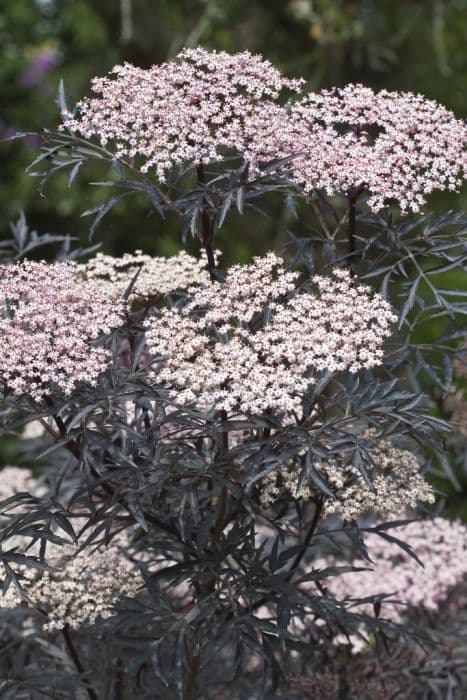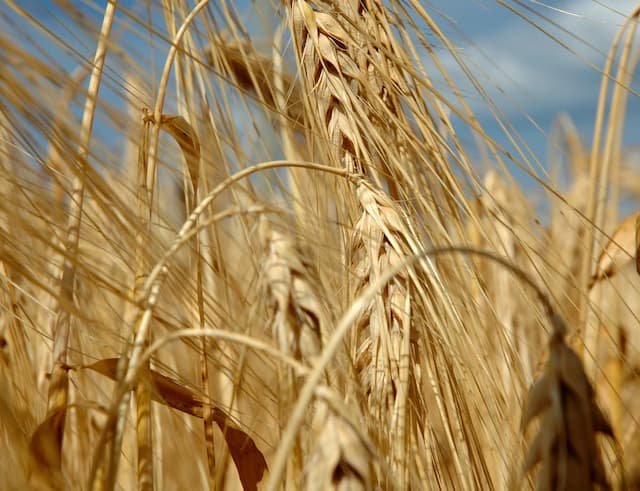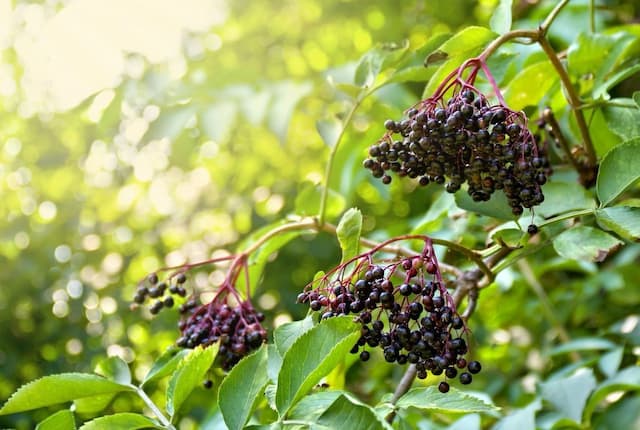Sambucus nigra f. porphyrophylla 'Gerda' (PBR)

ABOUT
The plant commonly known as Black Lace Elderberry or simply Elderberry has striking features that catch the eye. Its foliage is a dramatic dark purple to almost black color, creating a backdrop that makes the light pink flowers stand out vividly when they bloom in the spring. These flowers are small and delicate, presented in large, flat-topped clusters that give a lacy effect against the dramatic leaves. As the season progresses, these flowers may develop into dark berries that are often used in jams and wines. The dark leaves are finely cut, giving them an appearance similar to that of a Japanese maple. The overall effect is one of a plant that provides strong visual interest throughout the growing season with its contrasting colors and textures.
About this plant
 Names
NamesFamily
Adoxaceae
Synonyms
Black Lace Elderberry, Black Beauty Elder, Purple-leaved Elderberry
Common names
Sambucus nigra f. porphyrophylla 'Gerda' (PBR)
 Toxicity
ToxicityTo humans
Black Lace Elderberry, as it is commonly known, contains toxic substances that can be harmful if ingested in its raw form. The plant's leaves, seeds, twigs, and roots contain a cyanide-inducing glycoside, which can cause a toxic buildup of cyanide in the body. Symptoms of poisoning can include nausea, vomiting, diarrhea, dizziness, headache, and abdominal cramps. In severe cases, ingesting large quantities can result in more significant symptoms such as respiratory failure, seizure, and even death.
To pets
Black Lace Elderberry is also toxic to pets. The same parts of the plant - leaves, seeds, twigs, and roots - that are harmful to humans contain cyanide-inducing glycosides that can affect pets if ingested. Symptoms in pets can mirror those in humans, such as vomiting, diarrhea, abdominal pain, and lethargy. In severe cases, ingestion can lead to more serious issues including difficulty breathing, seizures, and potentially death, especially if large amounts are consumed. Pet owners should prevent their pets from chewing on or ingesting any part of this plant.
 Characteristics
CharacteristicsLife cycle
Perennials
Foliage type
Deciduous
Color of leaves
Dark purple
Flower color
Pink
Height
6 feet (1.8 meters)
Spread
6 feet (1.8 meters)
Plant type
Shrub
Hardiness zones
5
Native area
Europe
Benefits
 General Benefits
General Benefits- Ornamental Appeal: Adds visual interest to gardens with its dark purple foliage and clusters of pink flowers.
- Wildlife Attraction: Attracts pollinators such as butterflies and bees, which are essential for a healthy ecosystem.
- Edible Fruit: Produces black elderberries that can be used in making jams, jellies, and wines, offering a source of homegrown nutrition.
- Shade Provider: Can be grown as a small tree or large shrub, providing shade and cooler areas in gardens and landscapes.
- Seasonal Interest: Offers a variety of seasonal changes from flowers in spring, fruits in late summer, to fall foliage.
- Privacy Screening: With its dense growth habit, it serves as an effective natural screen for privacy in gardens and outdoor spaces.
- Drought Tolerance: Once established, shows a degree of drought resistance, reducing the need for frequent watering.
- Low Maintenance: Requires minimal pruning and care once established, making it a convenient choice for gardeners of all skill levels.
 Medical Properties
Medical Properties- Immune Support: The plant's berries are thought to contain vitamins and antioxidants that could help boost the immune system.
- Respiratory Health: It is traditionally used to help with colds, coughs, and other respiratory illnesses due to its expectorant properties.
- Anti-inflammatory: The flowers and leaves may have anti-inflammatory effects, which is why it is sometimes used in managing sinusitis and other inflammatory conditions.
- Diuretic Effects: The plant has been used for its diuretic properties, helping to increase urine production and alleviate fluid retention.
- Antiviral Activity: Some studies suggest that the plant contains compounds with antiviral properties, particularly against influenza viruses.
 Air-purifying Qualities
Air-purifying QualitiesThis plant is not specifically known for air purifying qualities.
 Other Uses
Other Uses- Photography Backdrop: Its dark foliage and attractive clusters of blooms make Black Elderberry an excellent natural backdrop for garden photography.
- Insect Repellent Sachets: Leaves of Black Elderberry can be dried and placed in sachets to naturally repel insects from wardrobes and linen closets.
- Horticultural Dye: The berries can be used to produce a natural dye for fabrics, providing a range of purples and blues when used with different mordants.
- Culinary Garnishes: The flowers of Black Elderberry, when fresh and clean, can be used as an edible garnish on desserts and drinks.
- Natural Confetti: Dried petals of Black Elderberry can serve as biodegradable confetti for outdoor celebrations and garden weddings.
- Fruit Syrups: The berries, while typically used for medical purposes, can also be cooked into a flavorful syrup for use in culinary applications like drizzling over pancakes or ice cream.
- Hedge Creation: Its fast growth and dense foliage make Black Elderberry suitable for creating living hedge screens for privacy in the garden.
- Frost Protection: The plant can be grown to provide shade and frost protection for more sensitive plants, creating a microclimate in the garden.
- Woodworking Projects: Although not commonly used, the wood of Black Elderberry can be crafted into small woodworking projects such as tool handles or carved ornaments.
- Bee and Butterfly Garden: Planting Black Elderberry can attract beneficial pollinators such as bees and butterflies to the garden, aiding the pollination of nearby plants.
Interesting Facts
 Feng Shui
Feng ShuiThe Black Lace Elderberry is not used in Feng Shui practice.
 Zodiac Sign Compitability
Zodiac Sign CompitabilityThe Black Lace Elderberry is not used in astrology practice.
 Plant Symbolism
Plant Symbolism- Protection – Sambucus nigra, commonly known as Black Lace Elder or Elderberry, has been associated with protection from evil spirits in folklore. It was often planted near homes to guard against negative influences.
- Healing – Elderberry is well-known for its medicinal properties, particularly its immune-boosting effects, making it a symbol of health and recovery.
- Prosperity – In some traditions, elder trees are believed to bring prosperity and protect wealth, due in part to their abundance of flowers and fruits.
- Wisdom – Elders are ancient plants and carry the symbolism of wisdom and insight, often linked with elder wise beings in various cultures.
- Rebirth – The Elder plant is also associated with rebirth and renewal because of its ability to regenerate quickly and sprout new shoots from the base.
 Water
WaterThe Black Lace Elderberry requires regular watering to keep the soil consistently moist but not waterlogged. During the growing season in spring and summer, it's crucial to water deeply once a week, providing about 1 to 1.5 gallons per session for a mature plant. Reduce watering in the fall and further in the winter when the plant is dormant. Overwatering can lead to root rot, so ensure proper drainage in the soil. In extremely hot weather or if planted in sandy soil, you may need to water twice a week to maintain moisture levels.
 Light
LightThe Black Lace Elderberry thrives best in full sun to partial shade. The ideal spot would be one where the plant receives at least six hours of direct sunlight each day, which promotes healthy growth and prolific flowering. Dappled sunlight can also be acceptable, especially in regions with very intense sun.
 Temperature
TemperatureThe ideal temperature for the Black Lace Elderberry is between 60°F and 85°F. It is hardy and can withstand minimum temperatures down to -20°F for short periods, which corresponds to USDA Hardiness Zones 4 through 7. Avoid exposing the plant to temperatures above 95°F, as excessive heat may stress the plant.
 Pruning
PruningPrune the Black Lace Elderberry in late winter or early spring before new growth starts to maintain shape, encourage bushiness, and remove any dead or damaged wood. Pruning can also stimulate the growth of the plant's characteristic dark, lacy foliage. Annual pruning is recommended, and cutting the plant back to ground level every few years can rejuvenate an older plant and improve its vigor.
 Cleaning
CleaningAs needed
 Soil
SoilBlack Lace Elderberry prefers well-drained soil enriched with organic matter, with an ideal pH range of 5.5 to 6.5. A mix of loam, peat, and perlite can provide the required texture and nutrients.
 Repotting
RepottingBlack Lace Elderberry does not typically require frequent repotting; it should be done every 3-4 years or when it outgrows its current container.
 Humidity & Misting
Humidity & MistingBlack Lace Elderberry thrives best in average outdoor humidity levels; it does not have specific humidity requirements as it adapts to natural conditions.
 Suitable locations
Suitable locationsIndoor
Place in bright indirect light, well-draining pot, and roomy space.
Outdoor
Plant in full sun to partial shade, mulch and water regularly.
Hardiness zone
4-7 USDA
 Life cycle
Life cycleBlack Lace Elderberry ('Sambucus nigra f. porphyrophylla 'Gerda' (PBR)) begins its life cycle as a seed, which, when sown in fertile, well-draining soil, will germinate and sprout into a seedling. As the seedling matures, it develops a strong root system and produces distinctive, deeply cut dark purple leaves, characteristic of its cultivar. During the spring and summer, it enters a rapid vegetative growth phase, where it can reach its mature height and spread. Throughout late spring and early summer, the plant flowers, producing clusters of pink flowers that attract pollinators and beneficial insects. After pollination, these flowers mature into small, dark purple berries by late summer to autumn, which provide food for wildlife and can be harvested for human consumption. In the winter, Black Lace Elderberry enters dormancy, shedding its leaves and reserving energy for the next growing season.
 Propogation
PropogationPropogation time
Early Summer
The most popular method of propagating Black Lace elderberry is through softwood cuttings. This technique is typically conducted in late spring or early summer when the plant's new growth is still tender and flexible. Cuttings should be 4 to 6 inches (10 to 15 centimeters) long, with several leaves left on the top. It's crucial to make a clean cut just below a leaf node, as this is where root growth will be stimulated. The cut end of the cutting is often dipped in rooting hormone powder to encourage root development and then inserted into a soilless potting mix. The cuttings are then kept in a humid environment with indirect light until roots have established, which usually takes several weeks. Regular misting or a plastic covering can help maintain the necessary humidity levels.









